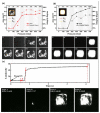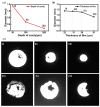Pressure Driven Rapid Reconfigurable Liquid Metal Patterning
- PMID: 37420950
- PMCID: PMC10146098
- DOI: 10.3390/mi14040717
Pressure Driven Rapid Reconfigurable Liquid Metal Patterning
Abstract
This paper proposes a method for pressure driven rapid reconfigurable liquid metal patterning. A sandwich structure of "pattern-film-cavity" is designed to complete this function. Both sides of the highly elastic polymer film are bonded with two PDMS slabs. One PDMS slab has microchannels patterned on the surface. The other PDMS slab has a large cavity on its surface for liquid metal storage. These two PDMS slabs are bonded together, face to face, with the polymer film in the middle. In order to control the distribution of the liquid metal in the microfluidic chip, the elastic film will deform under the high pressure of the working medium in the microchannels and then extrude the liquid metal into different patterns in the cavity. This paper studies the factors of liquid metal patterning in detail, including external control conditions, such as the type and pressure of the working medium and the critical dimensions of the chip structure. Moreover, both a single-pattern and a double-pattern chip are fabricated in this paper, which can form or reconfigure the liquid metal pattern within 800 ms. Based on the above methods, reconfigurable antennas of two frequencies are designed and fabricated. Meanwhile, their performance is simulated and tested by simulation and vector network tests. The operating frequencies of the two antennas are respectively significantly switching between 4.66 GHz and 9.97 GHz.
Keywords: a method for liquid metal patterning; control liquid metal; microchannels; reconfigurable antennas.
Conflict of interest statement
The authors declare no conflict of interest.
Figures






References
Grants and funding
LinkOut - more resources
Full Text Sources

